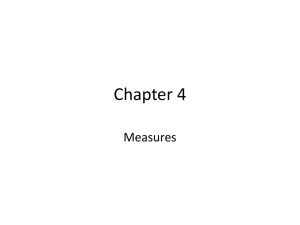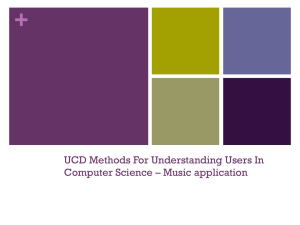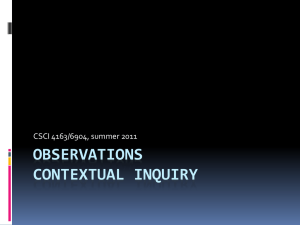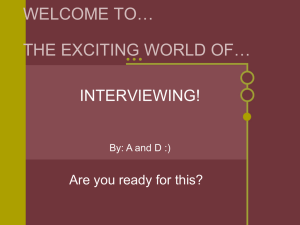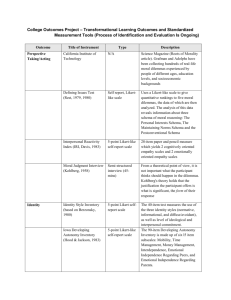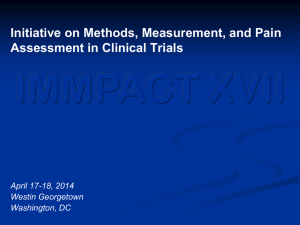Powerpoint
advertisement
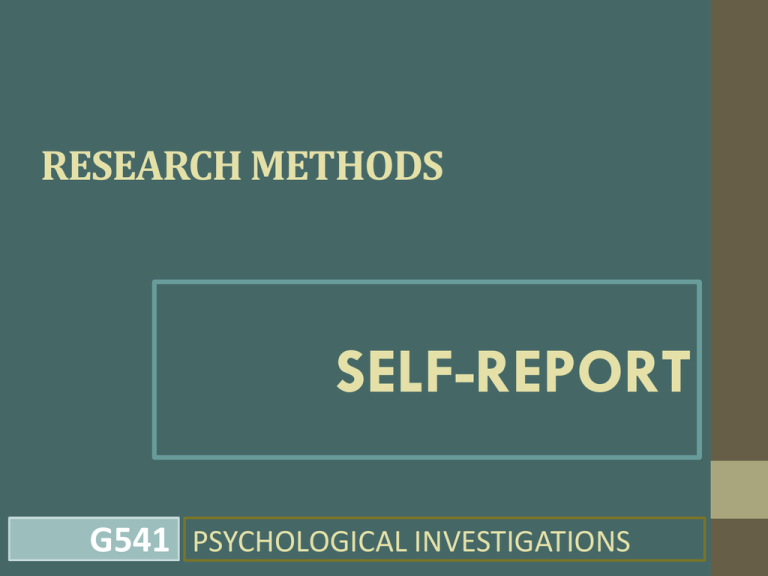
RESEARCH METHODS SELF-REPORT G541 PSYCHOLOGICAL INVESTIGATIONS CHECKLIST: Self-Report Be able to describe the terms self-report, interview, questionnaire, survey. Know strengths and weaknesses of self-report in general, and interviews, questionnaires and surveys specifically. Be able to describe terms open/open-ended questions, closed/closed-ended questions. Know strengths and weaknesses of both open and closed questions. Be able to describe the term rating scale. Useful also to be able to describe, Likert scale. Know strengths and weaknesses of rating scales in general . ACTIVITY 1 Worksheet 1: KEY WORDS Complete the key terms related to this topic You can use the resources and internet to help Each definition should be at least two sentences long You should use these terms where appropriate in your responses to exam questions EXAMPLE ESQ: June 2009 A researcher is Interested In finding out why students at a large sixth form college have decided to study psychology. He is going to use a self-report questionnaire. 1(a). Suggest one open and one closed question that could be used to investigate subject choice. (4) (b). Discuss the validity of the closed question you have suggested to investigate subject choice. (4) 2(a). Suggest how the researcher could use a random sampling technique to get 40 psychology students to complete the questionnaire. (2) (b). Evaluate the use of random sampling in this study. (4) 3(a). What is quantitative data? (2) (b) Outline one strength and one weakness of quantitative data in this study. (4) TOTAL: 20 MARKS RESOURCES: Self-Report • Internet • PowerPoint • Exam Style Questions (ESQ) ACTIVITY 2 Worksheet 2: Summary of the Self-Report Method Outline key features of the self-report method Identify ethical issues related to the self-report method Outline strengths of the self-report method Outline weaknesses of the self-report method KEY FEATURES: Self-Report Self-report is a method of data collection in which the participant themselves answer questions about their behaviour, thoughts and feelings. Questions may be asked in an interview or in the form of a questionnaire that participants are asked to respond to. Instead of using an objective method of data collection, participants are asked to make subjective judgements. Interviews are ac commonly used technique in clinical psychology and psychotherapy. They can be structured, semi structured or unstructured. Usually self-report questions are responded to by participants themselves, although occasionally others respond for them e.g. In the case of small children or people with learning difficulties who are unable to respond on their own behalf. The most common form of self-report in psychological investigations is the questionnaire or psychological measure. As with observations, self-report is a method in its own right, but it is also frequently incorporated into experiments ACTIVITY 3 Worksheet 3: Studies that use Self-Reporting Techniques Reicher & Haslam Thigpen & Cleckley Rosenhan Griffiths Studies that use self-reporting Study Reicher & Haslam Thigpen & Cleckley Rosenhan Griffiths Approach Role of Self-Report Method of Self Report: QUESTIONNAIRES KEY FEATURES: Questionnaires Questionnaires and psychological tests such as personality test and IQ tests are all self-report measures. Questions in a questionnaire can be open or closed. Open questions area open ended and allow free rein in answering them. Closed questions have a limited number of possible responses. They can be questions that require a simple yes/no answer or they require an answer from a range of possible answers. Questionnaires frequently use rating scale. They can consist of questions ore statements that participants respond to on a scale (e.g. Likert scale) where responses may take the form of ‘strongly disagree’ to ‘strongly agree’ on a scale of 1-4 where 1=strong disagree and 4=strongly agree. If participants have to select answers from a range of possible responses they can be referred to as forced-choice questions. OVERVIEW: Questionnaires Nature & Use Set of questions Design: open (qual) or closed (quan) Advantages •A lot of data can be collected •Does not require specialist administrators •People are more willing to answer embarrassing or personal questions on an anonymous written questionnaire than in a face-to-face interview Disadvantages •Leading questions, social desirability bias •Biased samples Ethical Issues Confidentiality Privacy Method of Self Report: INTERVIEW KEY FEATURES: Interviews Unstructured - Structured - Semi Structured a. Unstructured interview In an unstructured interview there is no predetermined structure in the interview, although the interviewer will normally have some goal or sense of direction in mind. The interviewer will ask open-ended questions and the answers given by the interviewee stimulate new questions. The directed but unstructured interview is the type of interview normally used in a therapeutic context as a therapist’s aim will enable the patient to talk. b. Structured interview In a structured interview the interviewer has a predetermined list of questions which they stick to. Respondents are all asked the same questions in the same order. c. Semi-Structured interview In a semi-structured interview the interviewer has a list of questions but the approach is flexible and can be shaped by the interviewee’s responses. OVERVIEW: Interviews Nature & Use Questions can be predetermined, or created in response to answers. Design: structured/ unstructured questions Advantages •Lots of ‘rich’ data •Telephone interviews Disadvantages •Social desirability bias, interview bias •Requires skilled personnel Ethical Issues Confidentiality Privacy EVALUATION: Different types of self-report methods Strengths Weaknesses Unstructured Interview Allows collection of rich, qualitative data Hard to compare responses Structured/ Semi-Structured interview Enable comparisons between participants responses Limit interviewees responses, so full information is not gained. Open ended questions Enable freedom to answer as they choose Makes statistical analysis difficult Close questions Enable collection of quantitative data and therefore make statistical analysis possible Limit interviewees responses, so full information is not gained. EVALUATION: Self-Reports STRENGTHS •Valuable method of investigating thoughts and feelings. •Practical research method that enables collection of large amount of data. •Measures are usually standardised and can be reproduced •Can produce numerical data that can easily be analysed •Self report is subjective and lacks scientific rigour •Interviewing can be time consuming and not usually conducted on large samples WEAKNESSES •It is not possible to gauge whether respondents are telling the truth in their responses. •Requires respondents to recall events or feelings, which effects reliability. PROCEDURE: Overview 5-7 marks Good description of procedure Good evaluation of procedure 2 strengths 2 weaknesses Describe (4 marks) •Type •Timing (20 min) •Who •Location •When (time of day) •IV/DV 8-10 marks In-depth description of procedure, including use of specialist terms In-depth evaluation of procedure 3+ strengths 3+ weaknesses Good use of grammar and limited spelling mistakes. Evaluate (6 marks) •Reliability •Validity •Ethics PROCEDURE: Plan 1. 2. 3. 4. What the researcher is going to do step by step. If it’s an observational method- what behaviour is going to be observed? Have you classified the behaviour and created a coding system? Have all the observers been chosen and given training on what behaviour to observe and record? How you chosen where the observation in going to be? Don’t forget your key terms- i.e. what type of experiment is it? - The strengths and weaknesses of that experiment type? Sampling methodstrengths and weaknesses of your sampling method and anything which might affect your sample (Cohort effect). Single Blind/Double Blind procedure? Any type of control method such as counterbalancing for repeated measures design? What type of design in it? Inter rater reliability? Ecological Validity? Ability to generalise? How about any ethical issues which might need to be considered for the study? How might they affect the results? How might you deal with them? (Remember-brief/debriefing for a laboratory experiment?) Remember- relate all these to the experiment in question. Responses need to be in context. If the experiment is a laboratory experimentinclude factors that affect laboratory experiments such as low Ecological validity which means it’s difficult to generalise outside a lab setting. PROCEDURE: Self-Report 1. 2. 3. 4. 5. 6. 7. 8. 9. Decide aim and research question & hypothesis Identify research method being used Identify variables Plan procedure: obtain ethics approval, outline how you will carry out this research, give examples of questions Possibly run pilot study in order to check feasibility Outline details of how you will collect data If, appropriate, thank and debriefed pts Analyse data, produce findings and draw conclusions Write report of practical investigation ACTIVITY 4 Worksheet 4: Exam Style Questions (ESQ) Complete the following ESQ for self-report Example ESQ: June 2009 Scenario 1: Modernising Supermarkets Scenario 2: School Library Scenario 3: Holiday Preferences Scenario 4: Happiness Levels EXAMPLE ESQ: June 2009 A researcher is Interested In finding out why students at a large sixth form college have decided to study psychology. He is going to use a self-report questionnaire. 1(a). Suggest one open and one closed question that could be used to investigate subject choice. (4) (b). Discuss the validity of the closed question you have suggested to investigate subject choice. (4) 2(a). Suggest how the researcher could use a random sampling technique to get 40 psychology students to complete the questionnaire. (2) (b). Evaluate the use of random sampling in this study. (4) 3(a). What is quantitative data? (2) (b) Outline one strength and one weakness of quantitative data in this study. (4) TOTAL: 20 MARKS Exam Style Questions: Self-Report Scenario 1 A large supermarket has decided to modernise its premises. The manager proposes to conduct a survey, asking customers what sort of refreshment/eating and drinking facilities they would like in the updated store. The survey will gather quantitative data. 1a. Sketch an appropriate chart for recording the findings of this study (4) 1b. Describe one limitation of the quantitative data will be recorded on this chart (2) 2. Identify two ethical issues the manager needs to consider when conducting this survey, and suggest how they could be managed (6) 3. Outline an appropriate procedure the manager could follow for this study (8) 1 Fictional category Number of pupils Science fiction 20 Fantasy 20 Crime 15 Thrillers 12 War 10 Romance 15 Historical 10 Humour 18 Scenario 2 A school librarian asked pupils to complete a questionnaire about the types of books they would like to see in the school’s fiction library. Pupils were asked to select three fictional categories. The school had a population of 500 pupils, 40 of whom returned a completed questionnaire to the librarian. 1a. Sketch an appropriate graph to represent the findings of this study (3) 1b. Draw one conclusion from the findings of this study (2) 2. Suggest why the findings of this study may not be valid (3) 3a. Suggest how the librarian could have obtained a random sample for this study (3) 3b. Describe one strength of using random sampling in this study (3) 4. Outline an alternative way the librarian could have measured the pupil’s fictional book preferences (6) 2 Exam Style Questions: Self-Report Scenario 3 A researcher used a structured interview to investigate people’s holiday preferences. He used open and closed questions to gather both quantitative and qualitative data about where people preferred to go on holiday, what type of holiday they enjoyed the most and what type of accommodation suited them best. 1a. Describe the terms ‘open question’ and ‘closed question’ (4) 1b. Give an appropriate ‘open question’ that could have used in this study (2) 2a. Describe a sampling technique the researchers could have used to obtain a suitable sample in this study (2) 2b. Describe one strength of using this sampling technique for this study (2) 3. Discuss the issues of reliability and validity in relation to this study (10) 3 Exam Style Questions: Self-Report Scenario 4 An office manager wanted to compare people’s happiness levels on Monday mornings with their happiness levels of Friday morning, to see if the through of coming to work for the next five days influenced their mood more then the though of the forthcoming weekend break. She decided to do this using a questionnaire in which participants had to apply a rating scale to reflect their levels of happiness. 1a. Describe an appropriate rating scale for this study (3) 1b. Outline one weakness of using a rating scale in this study (2) 2a. Describe the type of data gathered in this study (2) 2b. Outline one strength of this type of data in relation to this study (2) 3a. Suggest an appropriate alternative one-tailed hypothesis for this study (3) 3b. Explain what makes your hypothesis one-tailed (2) 4. Briefly discuss the issue of reliability in relation to this study (6) 4

